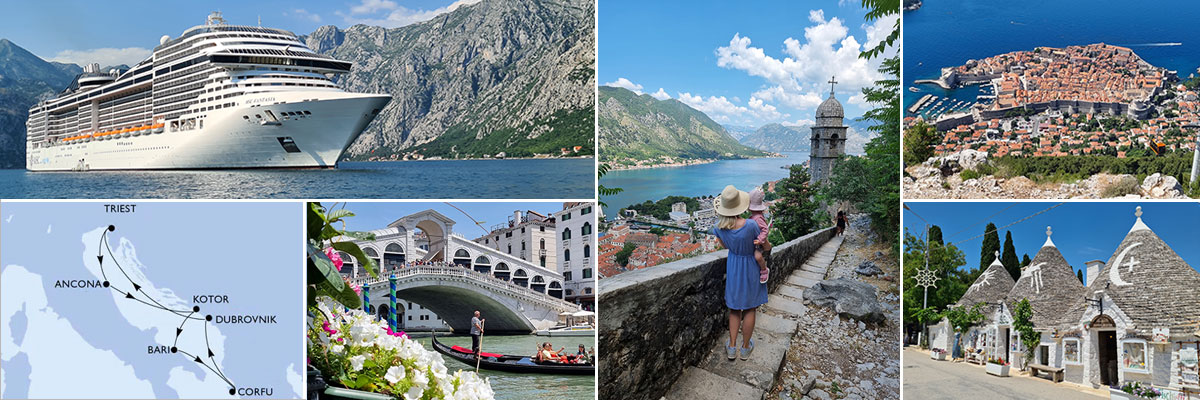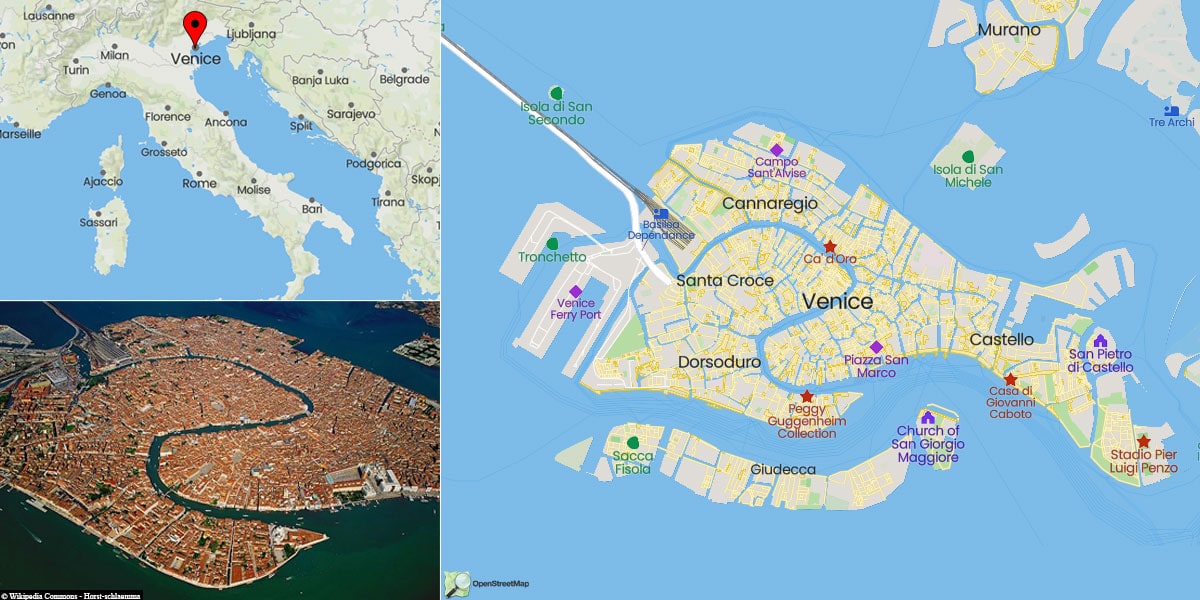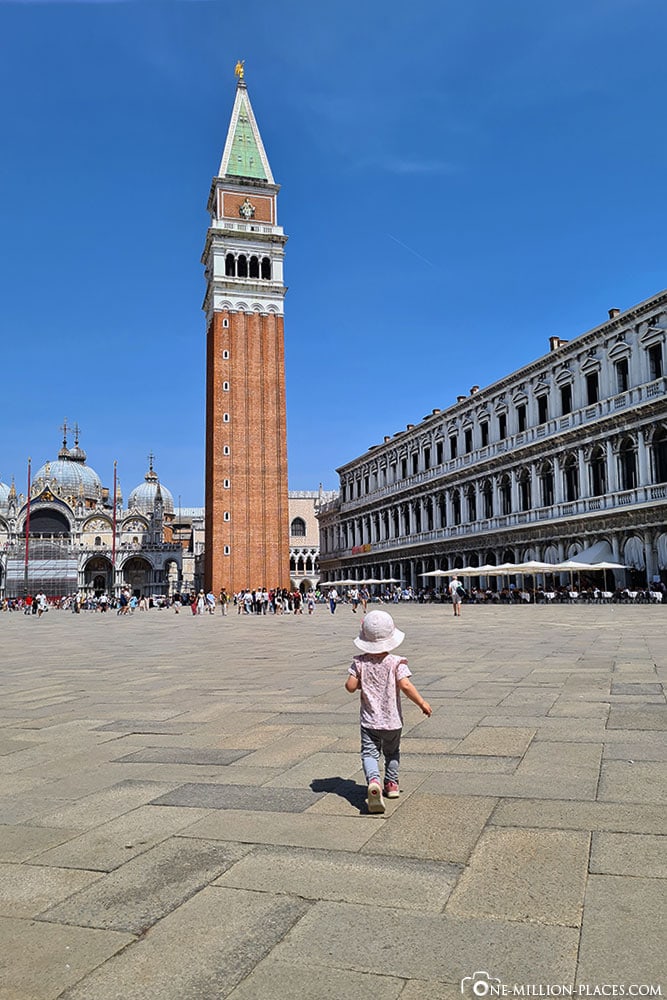After our MSC cruise through the Adriatic Sea was over, we were taken back to the Venice airport by transfer bus from Trieste. Since we still had about 7 hours until our departure flight in the evening, we decided to take the espress bus from the airport to Venice to see the main sights of the lagoon city. What we have seen in the 4 hours on site, we show you in this article.

Table of contents
Things to know about Venice
Venice is one of the most visited cities in the world. Before the Corona pandemic, up to 33 million tourists visited the city each year, an average of about 90,000 a day. This is more visitors than the city actually has inhabitants (about 55,000 in the historic center). This mass influx of tourists is not entirely surprising, because the location is very special: The city is located in the Venice Lagoon on more than 100 islands connected by more than 400 bridges and 175 canals. Venice and its lagoon have been on the UNESCO World Heritage Sites list since 1987.
The urban area was once built – when it became too crowded on the sandbanks and islands of the lagoon – on millions of wooden piles that were rammed into the firm clay soil. These piles have been sealed with oil and tar to withstand the water. However, the wooden piles sink a few millimeters into the ground each year, so Venice is at great risk of sinking (with sea levels rising at the same time). Due to the precipitation in the months between September and March, floods can occur again and again. This often occurs the legendary phenomenon Acqua Alta, in which the city is flooded. Rainwear and rubber boots are therefore essential items in your luggage during these months and should not be forgotten.
All the bridges and canals make Venice an absolute pedestrian city. The historic center is completely car-free – cars are only allowed to drive as far as the road embankment that connects to the mainland. In everyday life, everything else is done here by boat or on foot: whether cab, fire department, goods delivery, garbage collection or police.
The historic Venice Carnival, with its masks, animal fights, Hercules games and fireworks, is one of the most famous in the world. Every year in February, the city shines in a sea of colors during the Carnival celebrations that last several days. The costumes are classy, pompous & very elaborately designed and the supporting program is well filled with parades, stage shows and music performances.
By bus from the airport to the city
Since we did not want to take all our luggage for sightseeing, we stored it directly at the airport. For luggage storage, there is the Trasbagagli service office, which is open daily from 6 a.m. to 8 p.m. and whose entrance is outside the airport building: when you leave the airport building, keep left and you will pass almost directly by the luggage storage. Per piece of luggage one pays here 7 EUR for the first 6 hours, afterwards for each further hour 0.50 EUR.
To get from Marco Polo Airport Venice to the city, there are several options:
❶ Bus: The bus is the easiest and cheapest way to reach the city quickly from the airport. We chose this option and took the ATVO Express bus, which waits right outside the airport exit and usually leaves for the city every 30 minutes without stops. Per route you pay 8 EUR per person. The ticket is available directly at the bus. If you buy your return ticket at the same time, you pay 15 EUR for both routes together. Within 20 minutes we were at Venice’s main tourist terminal, Piazzale Roma.
❷ Water cab: With the water cab, for example, you pay 35 EUR one-way per person from Marco Polo Airport to the hotels in the city via GetYourGuide. The trip takes between 50-100 minutes.
❸ Taxi: By cab, you pay about 45 to 50 EUR each way into the city, depending on where exactly you want to go.
Venice hotels
The choice of accommodation in Venice is huge. Booking.com alone displays no less than 2,800 bookable hotels and accommodations – and that for every price range. The Gritti Palace, for example, costs just under EUR 4,500 for one night (without breakfast, of course) and the JW Marriott is “already” available for around EUR 1,000 per night. On the other hand, you can also sleep very cheaply at Hotel Adua for 50 EUR per night in a double room with shared bathroom. Very well rated guesthouses in top locations such as La Finestra sulle Beccarie can be had for around 200 EUR per night.
Our tour of Venice in 4 hours
Since we only had about 4 hours to get a first overview of Venice, we only went to the most important & famous sights in the lagoon city. We crossed countless bridges and canals and walked through winding alleys. With a stroller in the luggage (at most bridges you have to drag) such a tour almost bordered on competitive sport 😉
The Grand Canal
There are 175 canals in the old city of Venice, and one is the most famous: the main waterway Canal Grande, four kilometers long, between 30 and 70 meters wide and up to five meters deep, which runs in an S-shape through the lagoon city. Four bridges cross the canal, of which the Rialto Bridge is the oldest. As in all other canals, bathing and swimming in the Grand Canal is strictly forbidden (penalty: 350 EUR!). The Grand Canal is lined on the left and right by over 200 magnificent noble palaces.
The Rialto Bridge
The Rialto Bridge is one of the most famous structures in Venice and crosses the main waterway, the Grand Canal, which is almost 4 kilometers long. It has a length of 48 meters, a width of 22 meters and a clearance of 7.50 meters. The bridge was built at the end of the 16th century as a covered bridge in limestone (1591), replacing an old wooden bridge. Before the Rialto Bridge, three other bridges stood in succession in the same place.
The many bridges & canals
Walking through Venice, you automatically pass them on almost every corner: the more than 400 bridges and 175 canals. This actually makes sightseeing a big challenge, especially if you have a suitcase or stroller with you. Because then it is: carry, carry, carry.
In Venice there are “only” 435 bridges in total. By comparison, Hamburg has about 2,500 bridges, making it Europe’s city with the most bridges. In Venice, the bridges are an important element in the inner-city movement for pedestrians, because they connect the 120 or so islands that make up the city. After the Rialto Bridge, the Bridge of Sighs is the second most famous bridge in Venice. It is a building link bridge over the eight meter wide Rio di Palazzo and connects the Doge’s Palace on one side with the new prison on the other.
The streets of Venice are the many large water canals and the smaller ‘rii’, which have a total length of 38 kilometers and are used for everyday traffic. Besides their function as transportation routes, they themselves are considered one of the most photographed attractions of the city.
St. Mark’s Square
The most important and famous square in Venice is St. Mark’s Square, 75 meters long and up to 82 meters wide, where – in addition to important buildings – there are countless souvenir stands, cafes, restaurants and, of course, pigeons. The most imposing building in the square is St. Mark’s Basilica (‘Basilica di San Marco’) with its accompanying bell tower (‘St. Mark’s Tower’). Today’s St. Mark’s Basilica was built between 1063 and 1094 and served as the state and palace church of the Doges until the fall of the Republic of Venice in 1797. Since 1807 it has been the cathedral of the Patriarch of Venice. The 98.6 meter high bell tower is a landmark of the city and is considered the tallest building in Venice. Originally, it even served as a lighthouse for the ships.
In its extension, St. Mark’s Square reaches in front of the Doge’s Palace, where it opens onto the water. Since it is thus only minimally above sea level, it is often flooded during precipitation and high water and rapidly turns into an ankle-deep pool of water.
Gondola rides in Venice
A gondola ride in Venice is probably as much a part of the experience for many as a ride in the yellow cabs in New York. The gondolas are definitely one of the most popular tourist attractions in the city. Everywhere you can see the gondolas – some of them beautifully decorated – cruising through the canals, so it’s tempting to let a gondolier take you through the canals of Venice.
We often saw signs along the canals with the fixed prices for a gondola ride. We think it’s great that this is regulated so that no one has to feel like they’ve just been ripped off. As of June 2022, the prices were as follows:
During the day: 80 EUR, 30 minutes ride, maximum 5 people per boat.
Evening/night: 100 EUR, 35 minutes ride, in the period from 7 pm to 8 am.
Buildings & churches worth seeing in the old town
Walking through the old town of Venice, you will find historic buildings in almost every alley and canal. 124 churches from different eras – from Romanesque to Baroque – are said to exist in Venice. Unfortunately, since we didn’t have much time, we didn’t get to see any churches from the inside. We particularly liked the building of the Scuola Grande di San Rocco, the best preserved school of the six great brotherhoods of Venice, and the church of San Rocco next to it. In the building of the Scuola you can see an art exhibition with over 60 paintings by Jacopo Tintoretto, which are among his greatest masterpieces.
The Roman Catholic Church of Santa Maria Gloriosa dei Frari is also imposing and, along with the Church of San Zanipolo, is the largest and most important Gothic sacred building in Venice. It is furnished with many works of art and houses numerous funerary monuments of famous Venetians. In 1926 the church received the honorary title of papal basilica minor.
After a little over 3.5 hours of sightseeing in the city, we took the express bus back to the airport. We are happy that we could use the waiting time until our departure so well and get a first impression of Venice.
The most worth seeing islands around Venice
Of course, there are many more sights & attractions in Venice. Around the old town, for example, there are still numerous islands in the lagoon that can be visited as part of a day trip. Many can be reached most easily and cheaply by vaporetto (water bus). Among the most beautiful and worth seeing islands are:
Murano: The island of Murano is known for its centuries-old tradition of glassmaking and is therefore often referred to as ‘Glassblower’s Island’. Here everything revolves around glass: there is a glass museum, stores sell locally made vases, pendants & sculptures and in many places you can watch glass blowing.
Burano: The island of Burano has become famous through Instagram. Who does not know them: the colorful little houses, small canals and bridges? In any case, many photographers and Instagrammers cavort here on the hunt for the most beautiful photo motif. By the way, the island is also known for the luxurious Burano lace.
Isola di San Giorgio Maggiore: We did not visit the Isola di San Giorgio Maggiore ourselves, but we did see the white marble facade of the monastery complex from the shore near St. Mark’s Square.
San Michele: San Michele or ‘the island of the dead’ is an island in the north of Venice where the Venice Cemetery is located.
Torcello: The island of Torcello is the complete opposite of hectic Venice: here it is calm, quiet and green. An absolute place to relax and unwind.
Even though it was a very short visit to Vendig for us today, it was great to get some impressions of this great city on this beautiful summer day.
All travelogues of our cruise through the Adriatic Sea
We deliberately chose the 8-day cruise with MSC Cruises from Trieste, as it included some places that had been on our bucket list for a long time. In total, our trip took us through four countries: Italy, Montenegro, Greece and Croatia. We were able to experience six eventful and varied days on land: We started in Trieste, then continued to the port city of Ancona, through the breathtaking Bay of Kotor to Bari. The journey continued to the green island of Corfu and to medieval Dubrovnik with its impressive city walls, from where we returned to Trieste. Since our plane left from Venice, we were even able to make a small detour to the gondola city, which was another highlight of the trip. Cruise Day 1 » MSC Cruises – Cruise with MSC Fantasia in the Adriatic Sea
Cruise Day 1 » MSC Cruises – Cruise with MSC Fantasia in the Adriatic SeaCruise Day 1 » Trieste – Sights & the best Photo Spots in one day (Italy)
Cruise Day 2 » Ancona – The most famous sights in the old town (Italy)
Cruise Day 3 » Kotor – Bay, old town and fortification (Montenegro)
Cruise Day 4 » Bari – Top sights & photo spots in the old town (Italy)
Cruise Day 4 » Alberobello – A day trip from Bari to the Trulli houses (Italy)
Cruise Day 5 » Corfu – Discover the island in one day (Greece)
Cruise Day 6 » Dubrovnik – Top sights & photo spots in one day (Croatia)
Cruise Day 7 » Day at Sea
Cruise Day 8 » Venice - The most famous sights in just one day (Italy)


